Like fire, water leaks or floods can cause homeowners extensive property damage if left unattended. They can be a result of having leaky faucets or faulty pipes at home or be due to weather conditions, for example.
Like fire, water leaks or floods can cause homeowners extensive property damage if left unattended. They can be a result of having leaky faucets or faulty pipes at home or be due to weather conditions, for example. Flood/water leak sensors can be placed around home where water problems may occur to alert the homeowner when there is a problem. Early detection can help stop the problem and prevent further damage.
When there is an event, flood/water leak sensors will alert the homeowner typically via audible alarms and sometimes visual alerts as well. But what about when no one is at home? Smart flood/water leak detector is here to the rescue. With wireless communication and mobile apps, users are kept in the know even when they are away from home.
Must-have features
When it comes to smart flood/water leak sensors, leakSMART Spokesperson Ann Poston considers the following features essential: sensors must have reliable contacts that quickly detect water leaks and then alert the system; be an appropriate size to fit in small areas while still being visible; provide audible and/or visual alarms/alerts; have a long-lasting battery life; and can to be named/distinguished via an app.
Avi Rosenthal, vice president of Security & Control Products for Nortek Security & Control, expresses that besides the ability to detect water, durability and reliability are also important for these sensors. “Water/flood sensors must be able to detect water. As a homeowner, you’re counting on these devices to alert and notify you when water has been detected in your home so it’s important they perform as intended. Beyond that, it’s important for these devices to be durable and reliable.”
Types of flood/water leak sensors
In general, two types of smart flood/water leak sensors can be found – the “bug” type, and the type that has a wired probe. Users can choose the type they want based on where they intend to install the device. “The wired probe model is designed to be used in places where floods are expected and the level of water can reach more than a few centimeters,” says Oren Zandberg, program & project manager at The Crow Group. “In places like bathroom closet or faucet where there is not much space and floods rarely happen, the bug type is the best option due to small dimensions and easy installation.”
More sensors, more applications
Some smart flood/water leak sensors, like Fibaro Flood Sensor and WallyHome, incorporate additional environmental or motion sensors for expanded functionality and more versatile applications. Fibaro Flood Sensor has embedded temperature and tilt sensors, and WallyHome monitors temperature, humidity and movement in one.
“Many sensors are starting to feature a variety of other applications or uses, so that homeowners won’t need many different sensors, including temperature, humidity and motion,” says Poston.
Part of a smart home system, or a dedicated solution for preventing water damage
Smart flood/water leak sensors may be part of a larger smart home system, which can be developed by the same company or a third party. To take several examples, Samsung SmartThings Water Leak Sensor is part of the SmartThings ecosystem based around the Samsung SmartThings Hub; Fibaro Flood Sensor is part of the Fibaro System which includes a controller and various other sensors; and Z-Wave based GoControl Smart Flood Detector and Smart Flow Detector, just like other products under the GoControl brand, work with popular Z-Wave enabled home control hubs such as those from Samsung SmartThings, Wink, Nexia, Vera and many others.
Alternatively, smart flood/water leak sensors may be part of a dedicated solution that targets the particular application of preventing water damage at home. leakSMART is one example. It is a home water protection solution that includes hub, sensor and special valve connected to home’s main water supply. While the solution can be standalone, it can also be integrated with third-party smart home platforms including Wink, Iris by Lowe’s and Samsung SmartThings according to Poston.
Use of ZigBee and Z-Wave protocols are popular
ZigBee and Z-Wave are two popular wireless protocols for smart flood/water leak sensors. Companies like Samsung SmartThings and leakSMART adopt ZigBee for their flood/water leak sensors, while others like Nortek Security & Control and Fibar Group adopt Z-Wave. However, other communication technologies may also be used. SNUPI Technologies developed a unique communication technology called Sensor Network Utilizing Powerline Infrastructure (SNUPI), which is used in the company’s sensor solution called WallyHome. SNUPI takes advantage of the copper wiring in walls to create a sensor network and is ultra-low power.
1.
Nortek Security & Control
GoControl Smart Flow Detector
Wireless: Z-Wave
GoControl Smart Flow Detector takes a very different approach to help prevent leaks. It attaches to any copper water pipe at home to sense if there’s water flowing through the pipe without cutting the pipe. “The detector can be used to monitor the entire house and detects leaks on a more general level. It detects if water is flowing and then, depending on how long that activity has been going on, alerts the homeowner,” says Rosenthal. The device is interoperable with other Z-Wave solutions. It can work with Z-Wave enabled shut-off valves to shut off the flow of water if it detects water had been flowing for longer than the time allotment defined by the user.
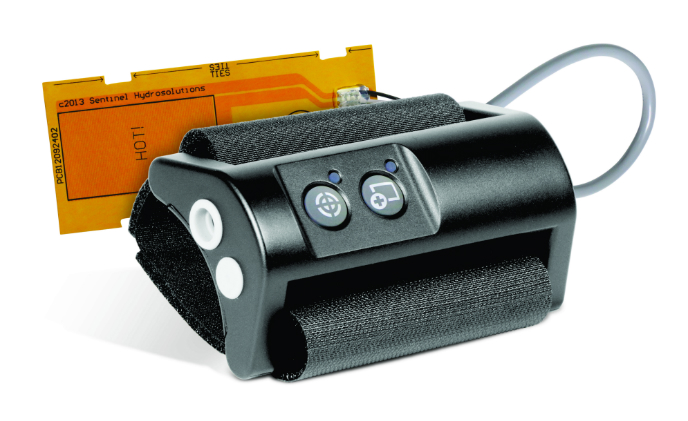 Photo courtesy of Nortek Security & Control
Photo courtesy of Nortek Security & Control
2.
leakSMART
Wireless: ZigBee
As mentioned previously, leakSMART comes with hub, sensor and valve (electronic motorized brass water ball valve). What is unique about leakSMART is that the valve, which connects to the home’s main water supply, will shut down the water supply automatically when there is a leak. The sensor can send audible alerts even if it’s not connected to the hub.
“leakSMART is working with a variety of smart home platforms to ensure that regardless of the chosen smart home platform by consumers, leakSMART can integrate with the system appropriately,” says Poston. She adds that leakSMART’s second-generation line of products will be launched in fall 2016.
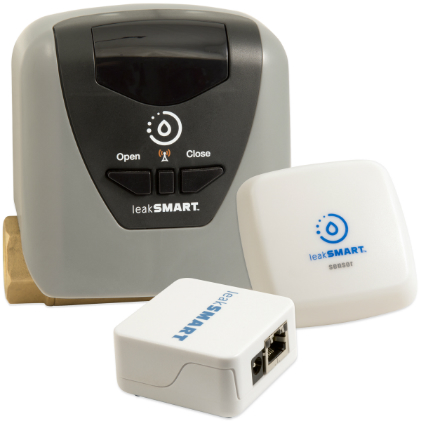 Photo courtesy of leakSMART
Photo courtesy of leakSMART
3.
Fibar Group
Fibaro Flood Sensor
Wireless: Z-Wave
Fibaro flood sensor has quite a few eye-catching features – tamper prevention, gold telescopic probes and ability to float in water.
With a tilt sensor that detects tilt and movement over 15 degrees and a tamper button, the device alerts the user if it has been moved or tampered with. Three 24-karat gold plated probes are found at the bottom of the device, and they have been designed to compensate for uneven surfaces. Besides, gold plating provides corrosion resistance and more precise detection.
In addition, the sensor provides temperature readings with its embedded temperature to Fibaro’s controller, Home Center 2, to help users manage floor heating.
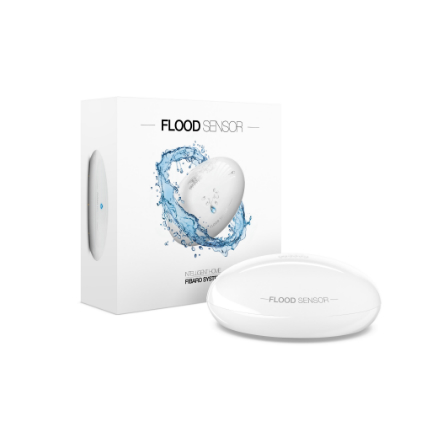 Photo courtesy of Fibar Group
Photo courtesy of Fibar Group
4.
The Crow Group (Crow)
DECT ULE FLD
Wireless: DECT ULE RF
DECT ULE FLD comes with a strong adhesive for easy installation. The device uses the DECT ULE RF protocol – a low current technology that will help save the battery. The device runs on two alkaline 1.5V batteries that can last up to four years.
The DECT ULE FLD can pair with a ULE compliant gateway/base station for remote configuration. With smart message control, it can verify if all messages have been successfully transmitted to the base station. Other features of the DECT ULE FLD include over-the-air SW update, battery status check on every transmission, and bi-color LED indicators for monitoring and pairing.
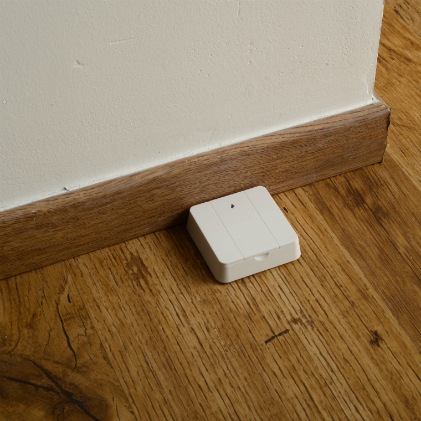 Photo courtesy of The Crow Group
Photo courtesy of The Crow Group
5.
SNUPI Technologies
WallyHome
Communication: SNUPI
Using the ultra-low power SNUPI technology and can last over 10 years. When Wally detects a water leak or sense that temperature/humidity falls outside the normal range, it will send SMS text message, email and push notification to alert the user.
Wally also works with the Nest Thermostat and IFTTT.
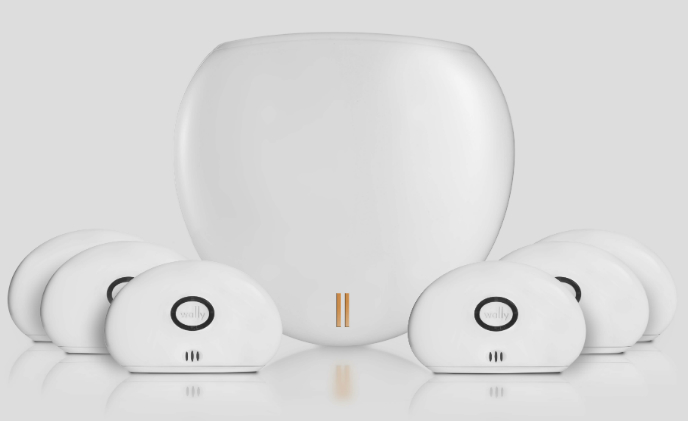 Photo courtesy of SNUPI Technologies
Photo courtesy of SNUPI Technologies
6.
Samsung SmartThings
Water Leak Sensor
Wireless: ZigBee
The Water Leak Sensor is powered by one CR-2 battery and requires connection to a SmartThings Hub for operation. With the embedded temperature sensor, it can notify the user when the temperature changes unexpectedly. It can also be used with the Samsung SmartThings Outlet for applications like turning on portable heaters when the temperature drops.
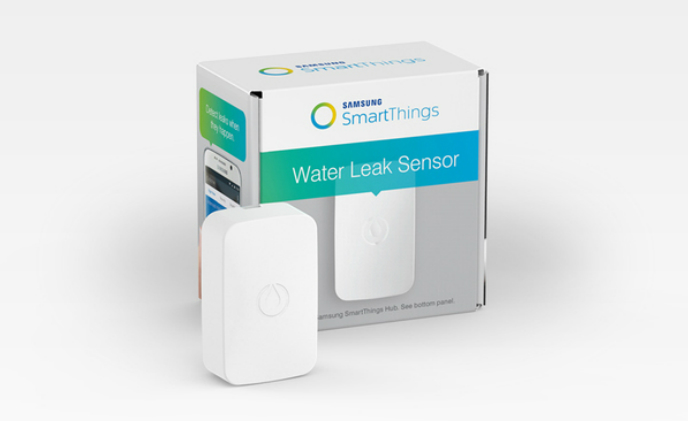 Photo courtesy of Samsung SmartThings
Photo courtesy of Samsung SmartThings
7.
Heiman
Smart Water Leak Sensor HS1WL
Wireless: ZigBee HA 1.2 / Z-Wave
The sensor comes in two versions – one supporting ZigBee HA 1.2 and the other one supporting Z-Wave. It operates on one CR2032 battery that can last up to a year and provides low battery warning. The device can be easily installed with 3M stickers.
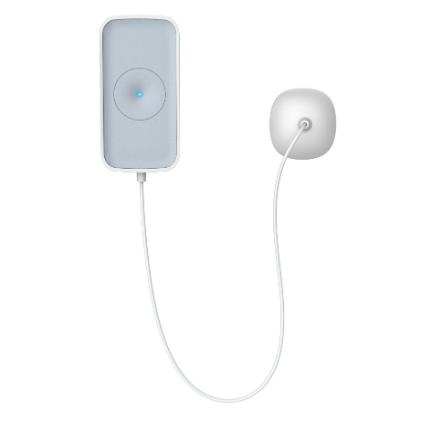 Photo courtesy of Heiman
Photo courtesy of Heiman
8.
Nietzsche Enterprise (NHR)
ZigBee Wireless Flood and Water Leakage Detector S05-WL
Wireless: ZigBee
This detector has a 2-meter long probe cable. With an IP-66 rated transmitter, the device can also be installed outdoors as a rain sensor. Connection with NHR's water valve A13 is possible. If disconnected from the base station, the detector will alert the user by activating the lamp and the buzzer. The detector supports remote monitoring and control using Sentrolcloud, the company’s own cloud services.
 Photo courtesy of Nietzsche Enterprise
Photo courtesy of Nietzsche Enterprise